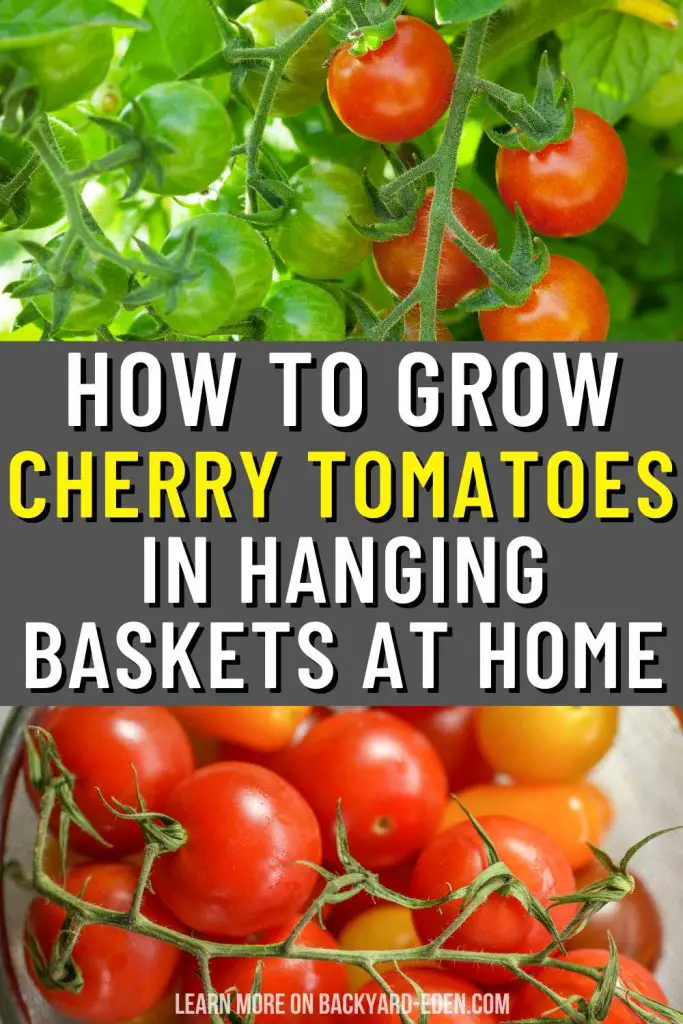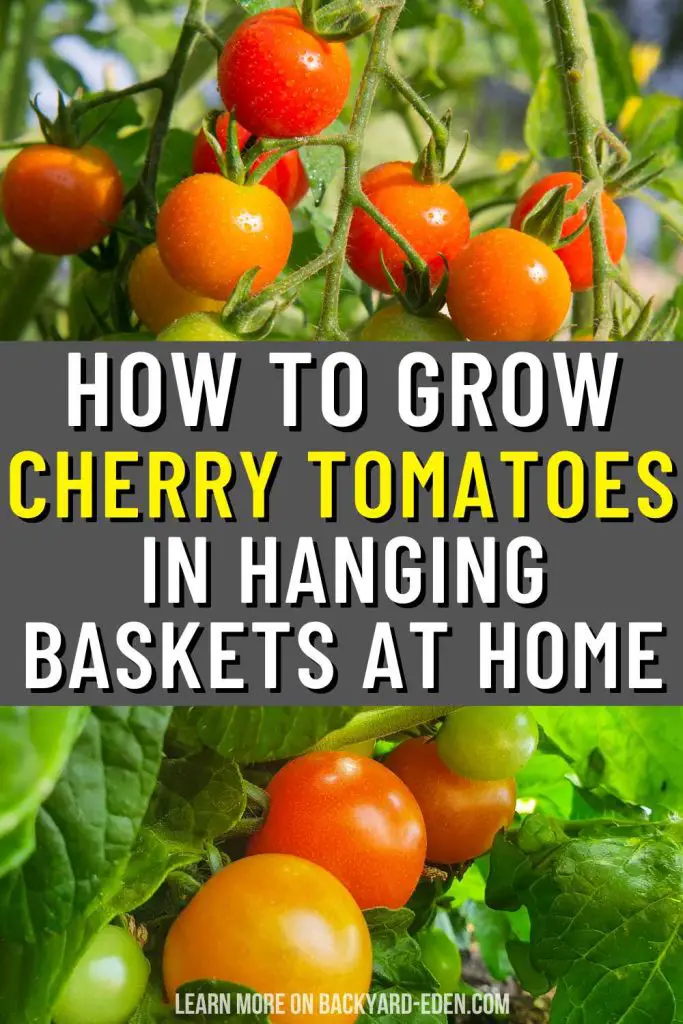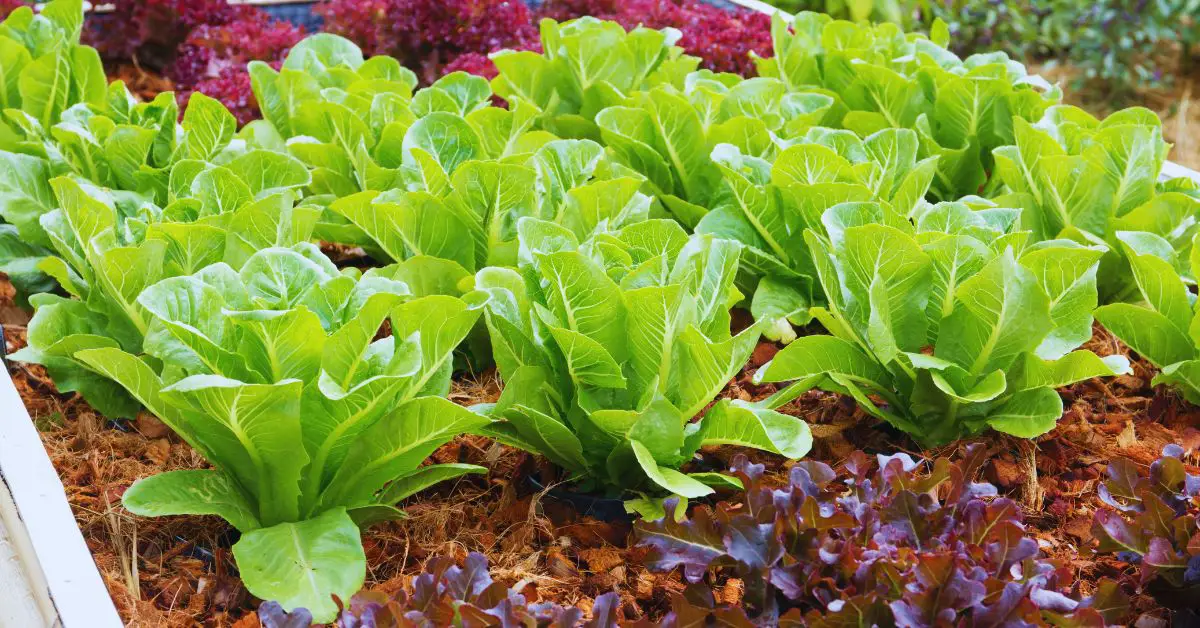Growing cherry tomatoes in hanging baskets is a brilliant way to maximize space while adding a splash of green and red to your patio, balcony, or even your front porch. This method of gardening is not just about saving space; it’s also about creating a living artwork that provides you with fresh, tasty tomatoes right at your fingertips.
Whether you’re an experienced gardener looking for new ways to display your plants or a beginner with limited outdoor space, hanging baskets offer the perfect solution. They can reduce pest problems, make harvesting easier, and can turn a sunny spot into a productive mini-garden.
In this guide, we’ll walk through the steps of selecting the right varieties of cherry tomatoes, preparing your hanging baskets, planting, and caring for your plants to ensure a bountiful harvest.
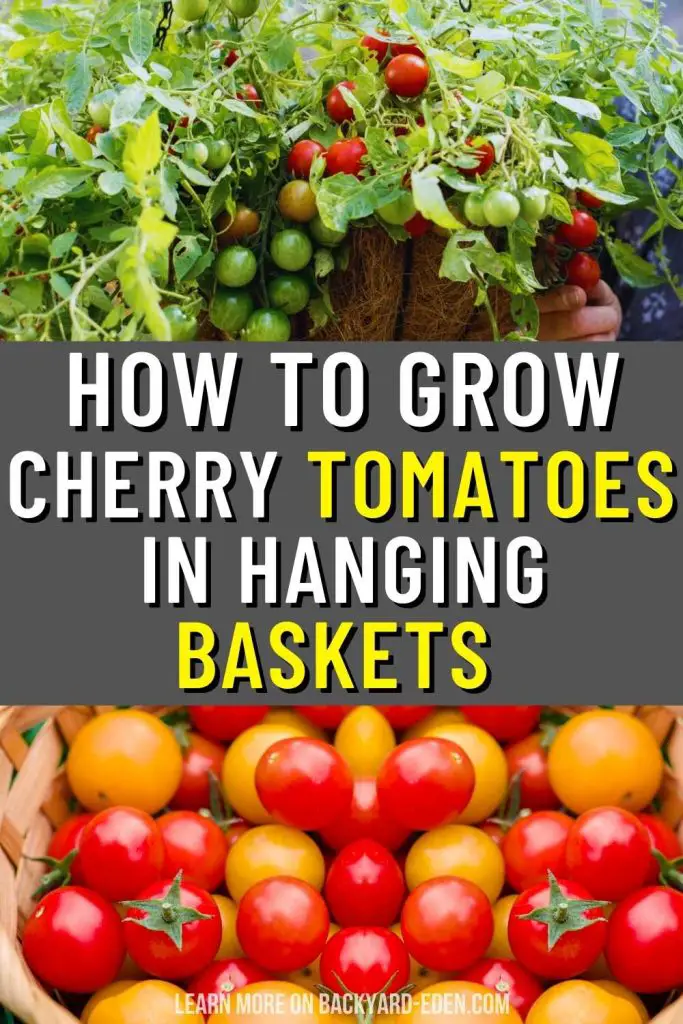
This post may contain affiliate links. Read our full disclosure here.
Why Choose Hanging Baskets for Cherry Tomatoes?
Space Efficiency
Hanging baskets are the ultimate space-savers. They allow you to grow vertically, freeing up precious ground space in small gardens, balconies, or patios. This makes them ideal for urban gardeners or anyone looking to add more greenery without sacrificing square footage.
Aesthetic Appeal
Cherry tomatoes in hanging baskets don’t just produce food; they create beautiful living decorations. The vibrant green of the leaves against the red, yellow, or even purple of the tomatoes adds a pop of color and life to any space.
Reduced Pest Issues
Growing cherry tomatoes off the ground means they’re less accessible to many common garden pests like slugs and certain insects. This natural pest control method can lead to healthier plants and cleaner fruit.
Ease of Harvest
No more bending over or searching through dense foliage on the ground. With hanging baskets, your cherry tomatoes are right at eye level, making it easy to spot and pick the ripe ones. This convenience makes the gardening experience more enjoyable and less strenuous.
Choosing to grow your cherry tomatoes in hanging baskets combines practicality with beauty, transforming your gardening space into a productive and visually appealing area.
Whether you’re looking to enhance your outdoor living area or simply grow your own food in a limited space, hanging baskets offer a flexible and rewarding approach to gardening.
Selecting the Right Cherry Tomato Varieties
Choosing the right variety of cherry tomatoes for your hanging baskets is crucial for success. Here’s what to consider:
Compact Varieties
Opt for compact or dwarf varieties specifically developed for container gardening. These plants tend to have a more bush-like growth habit, ideal for the limited space of a hanging basket. They focus their energy on producing fruit rather than sprawling vines.
Disease Resistance
Look for varieties with built-in resistance to common tomato diseases such as fusarium wilt, verticillium wilt, and nematodes. This can make a big difference in the health and productivity of your plants, especially in the unique environment of a hanging basket.
Your Taste Preferences
Consider the flavor and color of the tomatoes you enjoy most. Cherry tomatoes come in a wide range of flavors, from super sweet to tangy, and colors including red, yellow, orange, and even purple. Your choice should reflect what you love to eat because, after all, you’ll be enjoying the harvest.
Examples of Suitable Varieties:
- Tumbling Tom: Known for its cascading growth, making it perfect for hanging baskets.
- Tiny Tim: A dwarf variety that thrives in confined spaces with sweet, compact fruit.
- Balcony: Specifically bred for container gardening, producing sweet, bite-sized tomatoes.
Selecting the right variety not only ensures your cherry tomatoes will thrive in a hanging basket environment but also guarantees you’ll enjoy the taste and appearance of your harvest. With so many varieties available, you can experiment with different types each season to find your favorites.
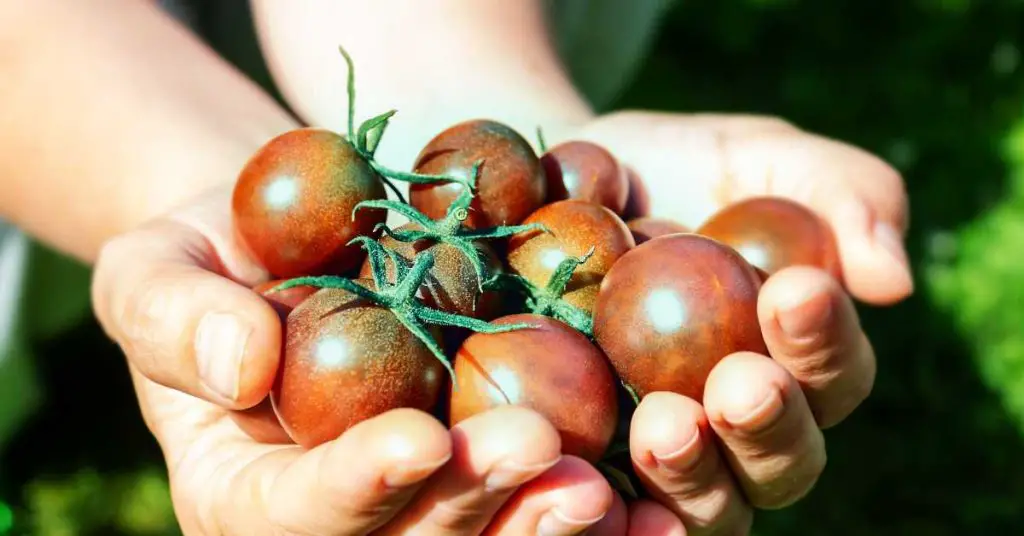
Choosing and Preparing Your Hanging Baskets
The success of your cherry tomato plants starts with the right hanging basket. Here’s how to choose and prepare one for the best results:
Size Matters
Select a basket that’s at least 12 inches in diameter. This size provides enough room for your tomato plant’s roots to grow and spread, ensuring they can access the water and nutrients they need to thrive.
Drainage
Good drainage is crucial to prevent waterlogged soil, which can lead to root rot and other issues. Make sure your hanging basket has several drainage holes at the bottom. If it doesn’t, you may need to add them yourself.
Quality Potting Mix
Fill your basket with a high-quality potting mix designed for container gardening. These mixes are formulated to retain moisture while also providing good drainage and aeration. They often contain a blend of peat moss, vermiculite, perlite, and sometimes compost, offering an ideal environment for cherry tomato roots.
Adding Support
Considering cherry tomatoes can grow quite vigorously, think about integrating support within the basket, like a small trellis or stake. This can help manage the plant’s growth and keep it upright, making it easier to care for and harvest.
Pre-Moistening Soil
Before planting, moisten the potting mix lightly. This ensures that the soil is ready to provide moisture to the plant’s roots immediately after planting, encouraging them to grow and establish themselves in their new home.
By carefully selecting and preparing your hanging basket, you set the stage for healthy growth and abundant production of cherry tomatoes. This preparation phase is critical in transforming a simple basket into a productive mini-garden that’s both functional and visually appealing.
Planting Your Cherry Tomatoes
Getting your cherry tomatoes started in hanging baskets involves a few key steps to ensure they have the best start possible. Here’s how to plant them:
When to Plant
Timing is important. Plant your cherry tomatoes after the last frost date in your area when temperatures are consistently warm. This prevents cold damage to your young plants. If starting indoors, you can begin a few weeks earlier and then move the baskets outside once it’s warm enough.
How to Plant
- Depth: Plant one cherry tomato plant per basket, positioning it slightly deeper than it was in its nursery pot. This encourages the formation of strong roots.
- Centering: Place the plant in the center of the basket to give it room to grow evenly on all sides.
- Watering: After planting, water your tomato plant thoroughly to settle the soil around the roots and eliminate any air pockets.
Choosing the Right Location
Hang your basket in a location that receives 6 to 8 hours of direct sunlight daily. Cherry tomatoes need plenty of sunlight to produce a bountiful harvest. Consider the movement of the sun and potential shade in your chosen location throughout the day.
Initial Care
In the first few weeks, keep an eye on your plant for signs of stress and adjust its position if necessary. Make sure it’s not too crowded by other plants or structures that could limit its light exposure or airflow.
Properly planting your cherry tomatoes is crucial for their development and fruit production. With the right start, they’ll grow into strong plants that can provide you with delicious tomatoes right from your hanging basket.
Caring for Your Cherry Tomato Plants
Once your cherry tomatoes are happily planted in their hanging baskets, regular care is essential to keep them thriving and productive. Here’s what they need:
Watering
Cherry tomatoes in hanging baskets require diligent watering. The elevated position and exposure can lead to quicker drying of the soil. Check the moisture level daily, and during hot weather, you might need to water twice a day. Aim to keep the soil consistently moist but not waterlogged.
Feeding
Feed your cherry tomato plants with a liquid tomato fertilizer every two weeks. This will provide them with the necessary nutrients to support their growth and fruit production. Starting with a nutrient-rich potting mix is good, but additional feeding will help sustain the plants as they grow and produce fruit.
Positioning
Ensure your hanging baskets are in a spot that receives ample sunlight—at least 6 to 8 hours of direct light daily. Sunlight is crucial for photosynthesis, the process by which plants produce energy, and ultimately, fruits.
Pruning
While not always necessary, pruning can help manage growth and improve air circulation around the plant. You can pinch off any non-productive branches or leaves, especially those that are shading the fruit, to focus the plant’s energy on tomato production.
Monitoring for Pests and Diseases
Keep an eye out for common pests such as aphids and treat any infestations promptly with organic pest control methods. Also, watch for signs of diseases like leaf spot or blight and remove any affected leaves to prevent spread.
Regular, attentive care will not only help your cherry tomato plants grow healthy but also ensure a continuous supply of delicious tomatoes throughout the season. Remember, the key to a bountiful harvest is a combination of consistent watering, proper feeding, and ensuring enough sunlight reaches your plants.
Supporting Your Plants
As your cherry tomato plants begin to grow and flourish in their hanging baskets, providing adequate support becomes essential to manage their growth and ensure a healthy, productive plant. Here’s how to support your cherry tomato plants effectively:
Understanding the Need for Support
Cherry tomato plants, especially vining varieties, can become quite heavy with foliage and fruit. Supporting them helps prevent branches from breaking under the weight and keeps the fruit off the soil, reducing the risk of disease and making harvesting easier.
Integrating Support Structures
Even though they’re in hanging baskets, cherry tomatoes can benefit from additional support structures. Options include:
- Small Trellises or Stakes: Insert a small trellis or stake directly into the basket’s soil. As the plant grows, it will naturally cling to and climb up the support.
- Soft Ties: Use soft ties or strips of cloth to gently tie the plant’s stems to the trellis or stake. Be careful not to tie them too tightly, as this can damage the stems.
Adjusting as Your Plants Grow
Keep an eye on your plants as they grow and adjust the support structures as needed. You may need to add more ties or reposition them to accommodate new growth and ensure the plant remains well-supported.
Benefits of Providing Support
- Improved Air Circulation: Properly supported plants allow for better airflow around the leaves and stems, reducing the risk of fungal diseases.
- Enhanced Sun Exposure: Supporting your plants helps keep them upright and open, ensuring that sunlight can reach more of the leaves and fruits.
- Ease of Care and Harvest: Supported plants are easier to inspect for pests and diseases, and the fruit is more accessible for harvesting.
By offering your cherry tomato plants in hanging baskets the support they need, you’re setting them up for success. Not only does this lead to healthier plants, but it also results in a more abundant and easier-to-harvest crop of delicious cherry tomatoes.
Pest and Disease Management
Keeping your hanging cherry tomato plants healthy involves vigilant pest and disease management. Here’s how to protect your plants and ensure a thriving crop:
Regular Checks
Frequent inspection of your plants is key. Look for signs of pests like aphids, whiteflies, or spider mites, as well as symptoms of diseases such as leaf spots or blight. Early detection allows for more effective treatment and can prevent minor issues from becoming major problems.
Organic Pest Control
For managing pests, consider organic options first. Neem oil, insecticidal soaps, and introducing beneficial insects like ladybugs can help control pest populations without harming your plants or the environment.
Disease Prevention
Many common tomato diseases are fostered by excess moisture on the leaves. Water your plants at the base to keep the foliage dry, and ensure your hanging baskets are positioned to receive good airflow. This can significantly reduce the risk of fungal diseases.
Removing Affected Parts
If you spot diseased leaves or stems, remove them promptly to prevent the disease from spreading. Dispose of them properly, away from your garden area, to minimize the chance of reinfection.
Choosing Resistant Varieties
When selecting cherry tomato varieties for your hanging baskets, look for those labeled as disease-resistant. These varieties have been bred to be less susceptible to common problems, giving you a healthier plant and a more bountiful harvest.
Proper pest and disease management not only keeps your cherry tomato plants healthy but also ensures that your efforts in growing them are rewarded with a generous supply of fresh tomatoes. Regular care, combined with preventive measures, can make all the difference in the success of your hanging basket garden.
Harvesting Your Cherry Tomatoes
The culmination of your gardening efforts is the rewarding process of harvesting. Here’s how to know when your cherry tomatoes are ripe and ready, and the best way to harvest them:
Knowing When to Harvest
Cherry tomatoes signal their ripeness through their color and firmness. When they reach their full color (whether red, yellow, purple, or another variety-specific hue) and are firm to the touch, they’re ready to be picked. The skin should be smooth and shiny, without any green spots near the stem.
Gentle Harvesting
To harvest, gently twist the tomato off the vine or use a pair of scissors or pruning shears to cut it, leaving a short piece of the stem attached. This method reduces strain on the vine and prevents damage to both the plant and the fruit.
Regular Harvesting
Frequent harvesting encourages the plant to produce more fruit. Check your plants every day or two, especially as the season reaches its peak, to ensure you’re picking ripe tomatoes and making room for new ones to grow.
Post-Harvest Care
After harvesting, store your cherry tomatoes at room temperature for the best flavor. Refrigeration is only recommended if you need to extend their shelf life for a few more days, but be aware that it can affect their taste and texture.
Enjoying Your Harvest
Freshly harvested cherry tomatoes can be enjoyed in a wide variety of dishes, from salads and pastas to pizzas and even as a sweet, healthy snack on their own. Their fresh, garden-grown flavor is incomparable and a testament to the care you’ve put into growing them.
Harvesting your cherry tomatoes not only marks the success of your gardening efforts but also brings the pleasure of incorporating home-grown produce into your meals. Enjoy the fruits of your labor and consider saving some seeds for next season, continuing the cycle of growth and enjoyment.
FAQ
Are Cherry Tomatoes Good for Hanging Baskets?
Yes, cherry tomatoes are excellent for hanging baskets. Their compact size and trailing growth habit make them well-suited to this type of gardening.
Hanging baskets allow cherry tomatoes to receive ample sunlight and air circulation, which promotes healthy growth and abundant fruit production.
Additionally, growing cherry tomatoes in hanging baskets can reduce the risk of soil-borne diseases and pest infestations, making for a healthier and more productive plant.
How Do You Grow Cherry Tomatoes in a Basket?
To grow cherry tomatoes in a basket, start by selecting a basket at least 12 inches in diameter with good drainage.
Fill it with a high-quality potting mix and plant one cherry tomato plant per basket, burying it slightly deeper than it was in its original pot.
Hang the basket in a location that receives at least 6 to 8 hours of direct sunlight daily. Water regularly to keep the soil moist, and feed with a liquid tomato fertilizer every two weeks.
Offer support with a small stake or trellis if necessary.
How Many Tumbling Tomatoes in a Hanging Basket?
For best results, plant one Tumbling Tom tomato plant per hanging basket. This gives the plant enough space to grow and spread without becoming overcrowded.
Overcrowding can lead to poor air circulation and reduced sunlight exposure, which may diminish plant health and fruit production.
Giving each Tumbling Tom tomato plant its own basket ensures ample room for growth and access to nutrients, leading to a healthier plant and a more bountiful harvest.
Which Cherry Tomatoes Are Best for Hanging Baskets?
Varieties like Tumbling Tom, Tiny Tim, and Balcony are among the best cherry tomatoes for hanging baskets.
These varieties are specifically bred for container gardening and have a compact, trailing growth habit that is ideal for hanging baskets.
They are known for their vigorous growth, disease resistance, and abundant production of sweet, flavorful tomatoes.
Choosing the right variety ensures your hanging basket will not only thrive but also provide you with a generous supply of cherry tomatoes throughout the season.
Conclusion
Growing cherry tomatoes in hanging baskets is a rewarding endeavor that combines the joys of gardening with the practicalities of space-saving techniques.
From selecting the right varieties to the moment you harvest those ripe, juicy tomatoes, each step brings its own satisfaction and challenges.
This method not only beautifies your space with lush, green plants and vibrant fruits but also provides a fresh, flavorful addition to your meals, directly from your own mini-garden.
By following the guidelines laid out in this guide—from preparation and planting to care, support, and harvesting—you’re equipped to successfully grow cherry tomatoes in hanging baskets.
Regular care, attentive pest and disease management, and the excitement of harvesting can make this gardening experience uniquely fulfilling.
Whether you’re a seasoned gardener looking for a new project or a beginner with limited outdoor space, growing cherry tomatoes in hanging baskets is an adventure worth embarking on.
It’s a testament to how, with a bit of creativity and effort, you can enjoy the bounty of the garden in any setting.
So, hang those baskets, plant those tomatoes, and get ready for a season full of growth, beauty, and delicious harvests.

